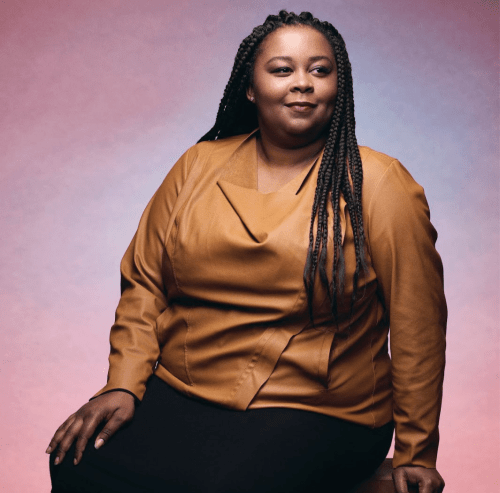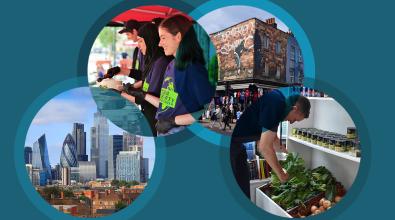5 insights to help city leaders stay focused on equity

The past year has pushed city leaders everywhere to take a new look at the ways they’re engaging the public and integrating residents' life experiences and insights into their work. These leaders are asking themselves, and each other, how they can push harder to make their human-centered design efforts even more human to ensure outcomes are equitable for residents.
That’s why Bloomberg Philanthropies recently invited Antionette Carroll, an expert in equity design, to share insights from her work with innovation staff in the Bloomberg Cities network. Carroll is the founder and CEO of Creative Reaction Lab, a St. Louis-based nonprofit that trains and deploys youth to challenge racial and health inequities impacting Black and Latinx people. Carroll also is a coach in the Bloomberg Philanthropies Innovation Training program, working with a team in Aurora, Ill., as they build new career pathways for Black and Latinx residents.
Carroll’s advice: Build relationships with communities whose perspectives have been ignored in the past and don’t just listen to what they tell you—but take action. “Like all systems, systems of oppression, inequality, and inequity are all by design,” Carroll says. “Therefore, they can be redesigned.”
It's a mindset that many city hall innovation teams already embrace. In Durham, N.C., for example, the city is building more opportunities for residents who have been involved in the justice system, while in Austin, Texas, the city is co-designing homeless interventions with a group of people who have lived experience with homelessness. Still, there’s more every city can and must do when it comes to equity, says Stephanie Wade, Lead for Innovation Programs at Bloomberg Philanthropies.
“In the past, many innovators felt that human-centered design, done with integrity, would inherently build equitable outcomes because it relies on co-creating with the people impacted by a problem to build new ideas that improve their lives,” Wade says. “But we have learned that even with good intentions, this doesn’t happen at the level it needs to. It’s not enough to passively rely on the human-centered design process, we’ve got to be intentional about building equity through our work if we are going to create meaningful changes in our society.”
Here are five insights from Carroll about how not just designers, but all city leaders, can do just that.
Remember that everyone is learning.
Centering your work in equity requires, first and foremost, a curiosity and willingness to learn about problems from other people’s perspectives. And while that can be exciting and rewarding, it can also be intimidating and uncomfortable—especially if you consider yourself a “newbie” in this work, Carroll says. But don’t let that get in your way. “Everyone on this equity journey is learning while doing because we don’t yet have a society of equity,” she says. “Even the folks who actually are experts in diversity, equity, and inclusion are still learning and unlearning.”
Invest in—rather than extract from—the community.
Research can be “exploitive, voyeuristic, paternalistic, and can create a lot of continual harm in spaces,” Carroll explains. But it doesn’t have to be that way. When your work is centered in equity, you invest the time to build relationships and trust with people in the community and are transparent about your goals and about who owns your research and how it will be used. “Innovation is built at the speed of trust, not at the speed of your agenda,” Carroll adds. “It’s not OK to go into a community and say, ‘I’m going to pull this data’ [without also] focusing on the authenticity and accountability it takes to actually build trust in a community.”
Focus on language.
To work toward “diversity,” “inclusion,” “equality,” and “equity,” city leaders have to first have a shared understanding of what those words mean. Carroll describes it this way: “Diversity” is inviting people to the party, while “inclusion” is inviting them to dance at that party. “Equality,” she adds, is ensuring everyone equal access, while “equity” is ensuring equal outcomes for people.
Language setting is also key to any community- or equity-focused work, Carroll says. “If we don’t first co-create language together, how are we going to co-create interventions to address issues that are collectively affecting all of us?” She shared the example of an apprenticeship program her organization runs to help formerly incarcerated youth of color create their own health-equity interventions. “One of the first things we did was co-create a language that they used throughout the program,” she says. “So, when we talked about ‘healthy food’ or ‘food justice’ they came up with collective definitions of those terms.”
Have humility.
Humility is the ingredient that enables successful human-centered design engaged with diverse communities. “Building humility means examining how our identities, values, biases, assumptions, and relationships to power and privilege impact how we engage with ourselves, each other, and the communities we work with,” Carroll explains. “Empathy without humility is still about you.”
Be accountable.
“Often the design process begins by trying to make the current state better,” Carroll says, “but the first step should actually be understanding what brought us to the current state in the first place.” She shared the example of Boston city leaders who, when they set out to refine the city’s resilience strategy, realized that they needed to consider Boston’s history. While the city has a highly educated population, a healthy economy, and world-class universities and nonprofit institutions, it also has a history of systemic racism that inhibited the full flourishing of these assets. After declaring the advancement of racial equality, social equality, and social cohesion key to the city’s resilience, the city engaged thousands of residents in a process that emphasized listening, accessibility, and a clear focus on racial equity. The resulting resilience strategy was so comprehensive that other cities now follow Boston’s work in building their own. A number of cities have gone beyond the creation of resilience strategies to identify equity indicators that help them gauge the real impact of their work.



